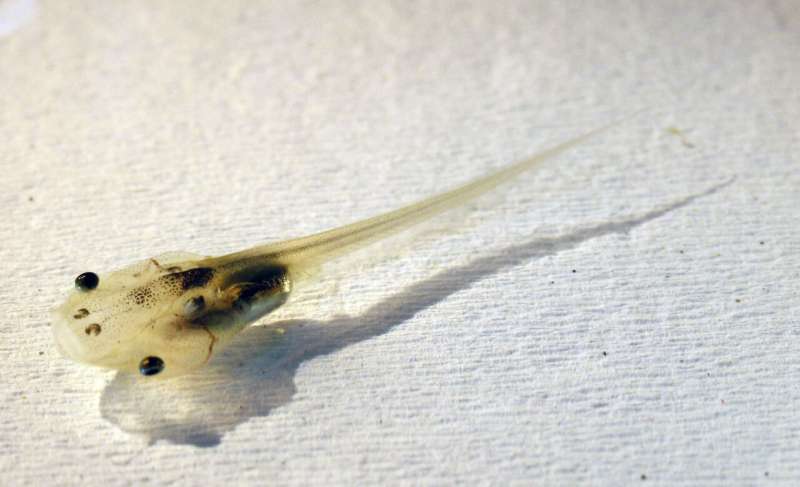Science
Researchers Unlock Mechanism of Tadpole Tail Regeneration

Researchers at the University of Tokyo have made a significant breakthrough in understanding the regenerative capabilities of tadpoles. They discovered that a protein called c1qtnf3 plays a crucial role in redirecting macrophages—immune cells—toward regenerative functions in the tails of Xenopus laevis tadpoles. This finding, published on November 17, 2025, in the Proceedings of the National Academy of Sciences, could have implications for regenerative medicine in mammals.
Understanding Tadpole Regeneration
The ability to regenerate lost body parts is a remarkable trait found in only a select few species, including the African clawed frog. Tadpoles of this species can fully regrow their tails, complete with spinal cord and muscle tissue. This complex process relies heavily on stem cells, which must activate at the right moment.
Researcher Taro Fukazawa noted the challenges of studying these initial regenerative steps due to the limited availability of stem cells. To address this, the team developed a method for efficiently isolating tissue stem cells, allowing them to examine the specific genes expressed during regeneration.
Through single-cell RNA sequencing, the researchers identified various cell types and focused on putative muscle stem cells, which exhibited higher levels of c1qtnf3 compared to other cells. The significance of this gene was further explored through “knockdown” experiments, where the gene’s expression was inhibited.
Sumika Kato, another member of the research team, explained that “the knockdown of c1qtnf3 resulted in impaired tail regeneration,” underscoring its essential role in the process. The experiments revealed a correlation between reduced numbers of macrophages at the tail stump and the inhibited regeneration in the knocked-down tadpoles.
Linking Macrophages to Regeneration
The study’s findings prompted the researchers to hypothesize that macrophages contribute to regeneration through a mechanism involving muscle stem cells and c1qtnf3. To test this theory, they aimed to “restart” macrophages using an alternative gene, neutrophil cytosolic factor 1, which is known to influence macrophage activity.
Kato remarked on the breakthrough, stating, “When I found that forced expression of the gene, and consequently rising macrophage numbers, rescued tail regeneration in tadpoles, it felt like the dots connected.” This led to a proposed mechanism whereby putative muscle stem cells secrete c1qtnf3, promoting macrophage accumulation at the tail stub, which in turn enhances the regeneration process.
Looking ahead, the researchers plan to further investigate how macrophages foster regeneration under the influence of c1qtnf3 and to clarify the specific cellular and molecular mechanisms involved in the regeneration of tissues. This research not only sheds light on the regenerative abilities of amphibians but also opens new avenues for exploring similar processes in mammals, potentially paving the way for advances in regenerative medicine.
For more information, refer to the study titled “Putative muscle cells promote Xenopus tail regeneration by modifying macrophage function via c1qtnf3,” published in the Proceedings of the National Academy of Sciences.
-

 Top Stories1 month ago
Top Stories1 month agoNew ‘Star Trek: Voyager’ Game Demo Released, Players Test Limits
-

 World1 month ago
World1 month agoGlobal Air Forces Ranked by Annual Defense Budgets in 2025
-

 World1 month ago
World1 month agoMass Production of F-35 Fighter Jet Drives Down Costs
-

 World1 month ago
World1 month agoElectrification Challenges Demand Advanced Multiphysics Modeling
-

 Science1 month ago
Science1 month agoTime Crystals Revolutionize Quantum Computing Potential
-

 Business1 month ago
Business1 month agoGold Investment Surge: Top Mutual Funds and ETF Alternatives
-

 Entertainment1 month ago
Entertainment1 month agoFreeport Art Gallery Transforms Waste into Creative Masterpieces
-

 Top Stories1 month ago
Top Stories1 month agoDirecTV to Launch AI-Driven Ads with User Likenesses in 2026
-

 Lifestyle1 month ago
Lifestyle1 month agoDiscover Reese Witherspoon’s Chic Dining Room Style for Under $25
-

 Health1 month ago
Health1 month agoGavin Newsom Critiques Trump’s Health and National Guard Plans
-

 Science1 month ago
Science1 month agoRemembering David E. Brest: A Life Dedicated to Nature and Family
-

 Lifestyle1 month ago
Lifestyle1 month agoLia Thomas Honored with ‘Voice of Inspiration’ Award at Dodgers Event







